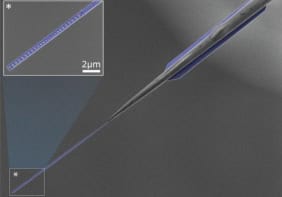
Even very small changes in the size and shape of a meniscus that forms between an object and the surface of a liquid can dramatically affect how much wave energy passes through this interface. The effect, seen for the very first time in an experiment, could come in useful for a host of practical applications that require fluid control, say the researchers at the University of Mississippi in the US who observed it.
When the upper surface of a liquid comes into contact with the container it is in or with another object, the layer of liquid at the interface curves upwards. This well-known capillary effect, produced by surface tension, is known as the meniscus.
In the new study, a team led by Likun Zhang at the National Center of Physical Acoustics and the Department of Physics at the University of Mississippi wanted to find out how the size and the shape of the meniscus affects the way waves move across it. In their experiments, the researchers filled a tank measuring 106 cm × 6.8 cm × 11 cm with distilled water to a height of 9.2 cm. They then placed a thin acrylic sheet 6.8 cm wide on the surface of the water to create the meniscus. Next, they sent surface waves with a frequency of about 15 Hz through the set-up using a paddle wavemaker and measured the ripples on the surface that resulted.
Precise adjustments
By varying both the frequency of the surface waves and the height and surface properties of the acrylic barrier (thanks to a surface coating to make it hydrophobic or hydrophilic), they were able to steadily adjust the meniscus very precisely – in steps of just 0.1 mm.
The researchers found that a slightly curved meniscus allows more wave energy to pass through the barrier. Conversely, if the meniscus curves more steeply, it reduces the energy transported by the fluid.
This is a counterintuitive result – we expect a barrier to block waves, explains Zhang. Instead, they observed that certain meniscus shapes can allow waves to pass through more easily. “Indeed, an adjustment of just a few millimetres can change the wave transmission by up to 60%, either going up or down depending on the meniscus shape,” he tells Physics World. “This is exciting because it’s the first time this effect has been observed in an experiment.”

Capillary condensation follows classical law even at the nanoscale
The discovery could open up new ways to control fluids more precisely – just by adjusting the meniscus, he adds. “This could be useful in open fluid channels, where liquids flow with a free surface exposed to air instead of being in a closed pipe. Such channels are common in nature and are also important in engineered systems, for example, in microfluidic devices, thermal control, and even technologies employed in space.”
The researchers, who report their work in Physical Review Letters, say they now plan to develop theoretical models to better explain the effect they have observed. “For example, why do waves transmit less when the meniscus height is tall, but more when it is short?” ponders Zhang. “In the longer term, our goal is to exploit this knowledge to design better ways of controlling fluids for practical applications.”



